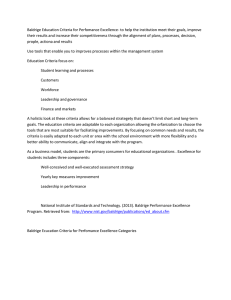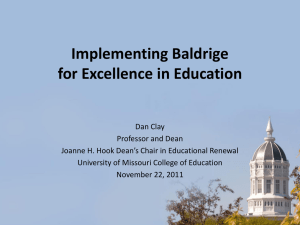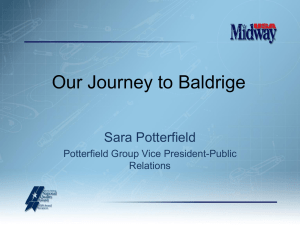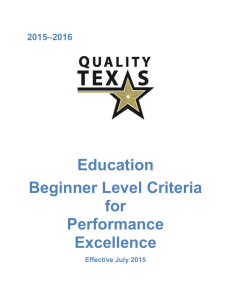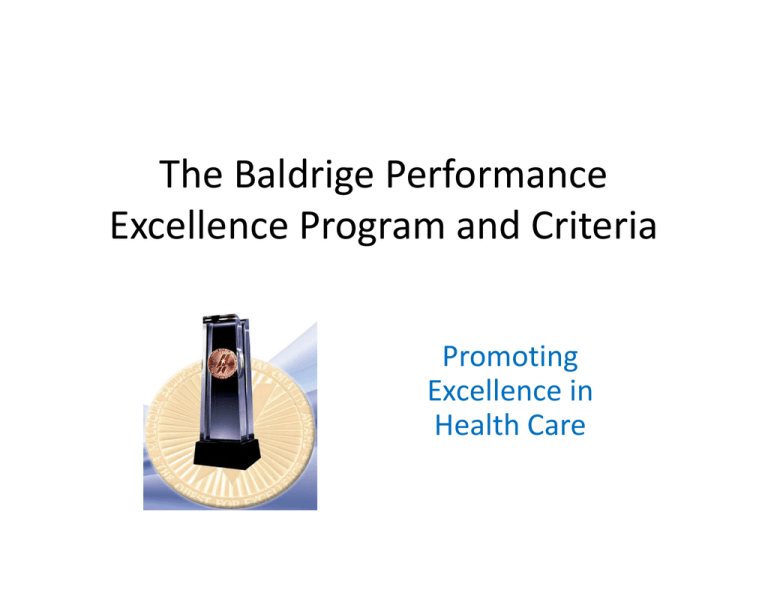
The Baldrige Performance
Excellence Program and Criteria
Promoting
Excellence in
Health Care
Objectives
Today, we will cover:
1.
2.
3.
4.
Background of the Baldrige Performance
Excellence Program
Basic concepts of the program framework
How the Baldrige framework can be applied to
improve your business area
Lessons learned from Baldrige recipients
Program History
Malcolm Baldrige National Quality
Improvement Act of 1987, Public Law 100-107
• Named after Malcolm Baldrige, Secretary of
Commerce from 1981-1987
•
Advocate of quality management to improve
the standing of U.S. businesses
• Highest level of recognition for performance
excellence in the U.S.
Program History
• Created award program to
Identify/recognize role-model businesses
Establish criteria for evaluating
improvement efforts
- Disseminate/share best practices
• Expanded to health care and education
(1998)
• Expanded to nonprofit sector (2005)
-
Baldrige Arrived!
(1994 – Public Culture)
Program History
• Criteria adopted / adapted by states,
regions
– Multiple levels
– Feedback, site visit opportunities
• Support through Alliance for Performance
Excellence
New
Eligibility at National Level
• Starting in 2012, an organization must meet one of the following
criteria to apply for the national Baldrige Award:
o Previously won the national Baldrige Award (not within the past 5
years);
o Between 2007 and 2011:
• Received the top award from an award program that is a
member of the Alliance for Performance Excellence;
• Applied for the national Baldrige Award and earned a high
score in both organizational processes and results but did not
receive a site visit;
• Applied for the national Baldrige Award and received a site
visit;
o Has more than 25 percent of its workforce outside of the home
state; or
o Is an organization that does not have an available Alliance for
Performance Excellence award program.
Quality Texas Award Levels
Baldrige National
Award Process
Texas Award for
Performance Excellence
State/Local
Recognition
Progress Level
Commitment Level
Engagement Level
The Texas Award for Performance
Excellence
•
Four Application Levels
1. Engagement – 10 page application, feedback
2. Commitment – 15 page application , feedback
3. Progress – 25 page application, optional site visit,
feedback
4. Award – 50 page application, site visit, feedback
9
What Is the Baldrige Program?
• Operates as a unique public-private
partnership
• Identifies & recognizes role-model businesses
• Forum for sharing best practices
• Educates organizations on achieving
performance excellence
• Manages the Malcolm Baldrige National
Quality Award
What is the Baldrige Framework?
• Criteria-based assessment and improvement
framework
• Non-prescriptive
• Uses a “systems perspective” to define an
organization
• Adaptable and scalable
• Proven approach - stock & performance study
Who Uses the Criteria?
•
•
•
•
•
•
Manufacturing
Service
Small Business
Education
Nonprofit (includes government agencies)
Health Care
Baldrige = Performance
Kevin Hendricks (College of William & Mary) and Vinod Singhal (Georgia Institute of Technology)
Applications by Award Categories
12 11 10 09 08 07 06 05
Manufacturing 1
2
3
2
3
2
3
1
3
3
2
4
5
4
4
6
Small Business 2
7
7
5
7
7
8
8
Education
3
8
10
9
11 16 16 16
Health Care
25 40 54 42 43 42 45 33
Nonprofit
5
Total
39 69 83 70 85 84 86 64
Service
14
7
8
16 13 10
-
Baldrige Healthcare Applicants
2005-2012
100
90
85
83
86
84
80
70
69
70
64
60
54
50
39
40
43
42
40
45
42
33
30
25
20
10
0
2012
2011
2010
2009
Health Care
2008
Total
2007
2006
2005
Does the Baldrige Framework
Really Work?
• Several studies have been done, including a comparison
with Thomson Reuters 100 Top Hospitals data
• Baldrige criteria categories align well with the 100 Top
Hospitals performance criteria
Baldrige Criteria
100 Top Hospitals Performance
Criteria
Leadership and governance
Composite score
Product and process
Patient outcomes: mortality,
complications, patient safety, core
measures
Customer focus
HCAHPS score
Financial and market
Profitability, expenses, length of stay
From: Foster, DA and Chenoweth, JC. Comparison of Baldrige Award Applicants and Recipients with Peer Hospitals on a
National Balanced Scorecard. Thomson Reuters. 2011.
16
Does the Baldrige Framework
Really Work?
17
The Feedback Report:
Your Greatest Benefit
• Written assessment of strengths/
opportunities for improvement
• Compiled by a team of expert examiners
– Key themes (summary)
– Organization-specific comments
– Individualized scoring information
– Scoring distribution
Comparing Performance Improvement
Tools
Baldrige
Business results and
organizational improvement and
innovation systems
Six Sigma, Lean, and ISO
9001
Organizational improvement and
innovation processes
Six Sigma and Lean
Drive waste and inefficiencies from
processes identified for improvement
by Criteria users
Comparing Performance Improvement
Tools
•
Baldrige and Joint Commission
Similarities
• Focus on continuous improvement
• Are based on a set of core values
• Offer a means for self-assessment
Think: Complementary
Baldrige and Joint Commission
Differences
Joint Commission
• Focuses on patient care
• Establishes minimum
standards for accreditation
• Looks at same things at all
institutions (like audit)
• Little emphasis on
approach, learning,
integration
Baldrige
• Overall organizational focus,
including focus on patients
• Recognizes role-model
performance
• Focuses on individual factors
and strategic challenges and
advantages (not audit)
• Heavy focus on
approach/process, learning,
integration
Baldrige and Magnet Similarities
– Both offer a systemic approach to transform the
organization
– Both focus on transformational leadership to
achieve culture change
– Both rely on self assessment supported by
independent assessment
– Both focus on alignment of key processes and
systems
Baldrige and Magnet Similarities
– Both require use of data to affect a fact-based,
knowledge-driven system
– Both focus on attracting, empowering,
developing, retaining, engaging workforce
– Both are non-prescriptive
– Both focus on achieving superior outcomes
(results)
Baldrige and Magnet Differences
• Baldrige
– 50 page application
– 5 page organization
profile
• Magnet
– No more than 15
inches in height
(approx. 2500 pages)
– Gather supporting
evidence
Criteria in Health care
• Used by:
- Mayo Clinic, Johns Hopkins, UCLA, Henry Ford,
Partners
- Baylor, THR, HCA, Cook Children's, JPS
• Compatible with
-
Magnet journey
TJC accreditation
IHI initiatives
Lean/Six Sigma, PDCA, etc.
Award Recipients: Health Care
• Advocate Good Samaritan
Hospital (2010)
• AtlantiCare (2009)
• Baptist Hospital, Inc. (2003)
• Bronson Methodist Hospital
(2005)
• Heartland Health (2009)
• Henry Ford Health System (2011)
• Mercy Health System (2007)
• North Mississippi Health Services
(2012)
• North Mississippi Medical Center
(2006)
• Poudre Valley Health System
(2008)
• Robert Wood Johnson University
Hospital Hamilton (2004)
• Saint Luke’s Hospital of Kansas
City (2003)
• Schneck Medical Center (2011)
• Sharp HealthCare (2007)
• Southcentral Foundation (2011)
• SSM Health Care (2002)
Testimonials from Health Care
Leaders
“The Award Criteria provide a well-tested approach to help achieve
higher levels of excellence. Health care organizations could benefit from
applying its rigorous Criteria in their efforts to improve quality, lower
costs, and better serve patients.”
—Robert R. Waller, former president and CEO, Mayo Foundation
“Baldrige . . . has offered us a way to systematically evaluate our entire
organization and understand the link between the hundreds of
processes that make up the health care experience. . .
—Sister Mary Jean Ryan, FSM, president/CEO, SSM Health Care, 2002 Award
recipient
Steps toward Mature Processes
Reacting to Problems (0–
25%)
Aligned Approaches (50–
65%)
Early Systematic Approaches (30–45%)
Integrated Approaches (70–100%)
From Fire Fighting to Innovation
The Baldrige Criteria
•
•
•
•
•
Validated set of criteria questions
Regularly updated (2 year cycle)
Useful as a performance assessment tool
Based on core values
Comprised of
•
•
•
Organizational Profile
Six Process categories
Results
•
•
•
•
Baldrige 2012–2013 Criteria
Categories
Leadership
Strategic Planning
Customer Focus
Measurement, Analysis, and
Knowledge Management
• Workforce Focus
• Operations Focus
• Results
Baldrige Criteria Framework:
A Systems Perspective
Core Values and Concepts
• Visionary leadership
• Customer-driven
excellence
• Organizational and
personal learning
• Valuing workforce
members and
partners
• Agility
• Management by fact
• Societal
responsibility
• Focus on results and
creating value
• Systems perspective
• Focus on the future
• Managing for
innovation
The Role of Core Values and Concepts
Organizational Profile
• Describes the key factors that are unique to
the organization
• Describes the organization’s priorities
• Describes:
•
•
•
•
•
Organization Environment
Organizational relationships
Competitive Environment
Strategic Context
Performance Improvement System
The Criteria Structure
The Criteria Structure
The Criteria Structure
The Criteria Structure
Evaluating Process
Process: methods used and improved to
address categories 1–6
Evaluation factors
•
•
•
•
Approach
Deployment
Learning
Integration
ADLI
Evaluating Results
Results: Outputs and outcomes in achieving the
requirements in items 7.1–7.5
Evaluation factors
• Levels
• Trends
• Comparisons
• Integration
LeTCI
Category Point Values
1
2
3
4
5
6
7
Leadership
120
Strategic Planning
85
Customer Focus
85
Measurement, Analysis, and
Knowledge Management
90
Workforce Focus
85
Operations Focus
85
Results
450
TOTAL POINTS
1,000
Scoring of Applications, 2008–2012
Process
Band
0–150
200
8
5
6
4
4
0
Results
Band
0–125
151–200
10
8
6
3
0
201–260
21
23
28
21
261–320
47
50
39
321–370
15
13
371–430
2
431–480
481–550
2009 2010 2011 2012
2008 2009 2010 2011 2012
18
21
16
13
8
126–170
34
29
27
17
8
16
171–210
26
27
30
17
37
26
45
211–255
15
19
23
17
29
22
13
39
256–300
6
4
4
4
18
0
1
1
0
301–345
1
0
1
0
0
0
0
0
0
0
346–390
0
0
0
0
0
0
0
0
0
0
391–450
0
0
0
0
0
2012 Average Category Scores
80
Service
Health Care
70
Education
Nonprofit
Percent Score
60
50
40
30
20
Leadership
Strategic Planning Customer Focus
Measurement,
Analysis, &
Knowledge
Management
Category
Workforce Focus Operations Focus
Results
Key Excellence Indicators: Leadership
Senior leaders
• communicate and demonstrate clear direction
and values
• inspire the highest standards of legal and
ethical behavior
• model and encourage learning, innovation,
excellence, and a focus on the future
• drive strategies for performance excellence and
sustainability
Key Excellence Indicators: Leadership
The governance body
• is informed, transparent, and accountable
• takes responsibility for ethics, actions, and
performance
The organization
• surpasses legal and regulatory compliance
• stresses ethical behavior
• strengthens environmental, social, and
economic systems
Texas Health Resources:
Alignment with our Leadership System
48
Clinical Support Services Quarterly Performance
Management Tool
Meeting Information
Title: Quarterly Business Review: Chaplaincy & Pastoral Education
Date:
Meeting Purpose: Discuss and review department’s status in reference
to key performance indicators and critical success factors as indicated on
the department scorecard
Q1: September-November
Review Period:
(click in check
box to select)
Q2: December-February
Q3: March-May
Q4: June-August
Instructions:
1. Director completes sections A-G prior to Performance Management meeting with VP, CSS
This tool consolidates
key departmental
performance
information into one
document for quarterly
review meetings.
a. Key performance indicator data for People, Service, Quality and Finance will be pre-populated.
b. Specific instructions for completing sections A through G are provided in those sections.
2. Director brings:
a. Two (2) copies of their department's FY12-FY14 Strategic Planning Summary document.
b. Two (2) copies of this completed Performance Management Quarterly Meeting document.
3. Director should be prepared to review and discuss all information provided.
PEOPLE
Key Performance Indicator
(P1) Monthly Retention Rate: % of employees retained
each month
U n d er
P erf orm in g
T h resh old
T arg et
S tretch
≤ 94%
95% - 97%
98%
≥ 99%
(P2) Performance Evaluation Compliance : % of
evaluations completed on time
U n d er
P erf orm in g
T h resh old
T arg et
S tretch
≤ 89%
90% - 94%
95% - 99%
100%
Q1
Q2
100%
95%
Q1
Q2
Data Not available
Data Not available
Q3
Q4
Q3
Q4
49
FY14 Clinical Support Services Goal Alignment
This tool is used
division-wide with employees
to illustrates strategic goal
alignment from Institutional
Strategies through individual
employee goals.
Mercy Health System: Leadership
Robert Wood Johnson: Leadership
5 Pillar
Communication
Direction and Plan
5 Pillar
Communication
Customer Groups
Evaluation &
Improvement
Patients
Employees
Community
5 Pillar
Communication
Alignment &
Integration
5 Pillar
Communication
Deployment &
Measurement
Robert Wood Johnson: Leadership
Staff Focus
People
Customer Focus
Service
Process Management
Quality
Measurement, Analysis &
Knowledge Management
Finance
Strategic Planning
Growth
Five Pillars of Excellence
Key Excellence Indicators:
Strategic Planning
Strategy development
• aims for sustained leadership
• balances short- and long-term factors
• anticipates the future environment
• incorporates innovation, stakeholders’
needs, challenges, and advantages
• aligns work systems and learning with
strategic directions
Key Excellence Indicators:
Strategic Planning
• Develops aligned, consistent action plans
• Deploys action plans to the workforce, key
suppliers, and partners
• Tracks the accomplishment of action plans
• Develops human resource and financial
plans
• Uses performance projections and
comparisons
THR Strategy Development and Implementation Process
cascades strategic themes and objectives into the org
Strategy Implementation Process
1
1
Mid-range
System Strategic Plan (SSP)
2
4
System Strategy
Initiatives
3
Zone / Entity
Imperatives
Annual
Resourc
e Plan
(Budget,
People,
IT)
5 Department / Team / Personal
Action Plans
6/30/2016
• Three-year cycle; yearly refresh
• Strategic goals, standards of performance, timing
• Initiatives across 16 Objectives
• Initiatives scoped by ELC; sponsored by ELC
members
2
• Driven by Strategy Initiative Teams (SITs)
• Initiatives chartered with measureable plans and goals
• Develop zone- and entity-specific initiatives
3 • Align to System Strategy
• Refine based on alignment to system plan and to
entity budgets
• Yearly resourcing process for strategy initiatives
4 • Top-down input from system; bottom-up input from
entities and functions
5
• Align to Strategic Objectives and when individual is
allocated against strategy initiatives or action plans
• Develop individualized action plans for day-to-day
operational needs
Confidential And Proprietary – All Rights Reserved – For Internal Use Only
Texas Health Resources
56
Strategic Objectives are broken down into “Initiatives,” and
Initiatives are broken down into “Action Plans”
“Strategy on a page”
Describes all Strategic
Objectives
“Blue Sheet”
Describes each Strategic
Objective and all
“Initiatives”
6/30/2016
“Green Sheet”
Describes each Initiative in
full detail
Confidential And Proprietary – All Rights Reserved – For Internal Use Only
Texas Health Resources
“Purple Sheet”
Describes each Action Plan
associated with an initiative
57
What we’ve learned from our Category 2 efforts
•
The “right people” and the “right process” produce the “right strategy”
− We transformed the Texas Health strategy team by bringing in people with a
skill for inductive insight and by developing and deploying a data-rich process
− We base all of our strategic decisions on insights developed from data-rich
research
•
Strategic execution is a team sport and it requires a scoreboard to win
− Effective deployment of any strategy involved the coordinated efforts of many
people—from the strategists, to the deployment teams, to the process owners
− Tracking the execution of all of our strategic initiatives requires consistent
oversight, which occurs best if there are clear lines of accountability
•
Strategy is never done
− Strategy is not a static event—a one-time set of decisions
− Strategy is dynamic and requires adaptability to remain relevant
− The market and competitors are constantly moving, so systemic refreshes of
the strategy are required
6/30/2016
Confidential And Proprietary – All Rights Reserved – For Internal Use Only
Texas Health Resources
58
Clinical Support Services Annual Strategic Planning Process
APPROACH
Annual Review Process:
Q1 Review and Update Plan
2
Gather and Analyze
Data
Division/Department Step 1:
Get Ready
Division/Department Step 2:
Assess the Situation
Full Strategic Planning Cycle Occurs Every Three Years
Strategic Plan Review Cycle Occurs Every Year
1
Review Process
3
Develop & Prioritize
Strategies
Division/Department Step 3:
Identify Strategic Challenges
& Strategic Objectives
4
Set Action Items
and Goals
Division/Department Step 4:
Draft a Written Strategic Plan
DEPLOYMENT
Annual Review Process: Q2 Implement Changes
5
Review and Allocate Resources
6
Communicate and Align
Division/Department Step 4:
Draft a Written Strategic Plan
Division/Department Step 5:
Internal Review and Feedback
Division/Department Step 6:
Finalize Strategic Plan
LEARNING & INTEGRATION
Annual Review Process: Q3 Monitor Progress &
Report Results
7
Develop Action Plans and Monitor Progress
Division/Department Step 7:
Review Strategic Plan Summary and Adjust Action Plans as Needed
(Confirm Alignment with Institutional Strategic Objectives and Goals)
59
FY14 Division of Clinical Support Services
Strategic Goals
The CSS strategic plan captures 3 years of strategic objectives, goals, and action
plans at a time and is:
• Directly aligned with institutional strategies and goals
• Updated annually
• Organized around the 5 pillars of People, Service, Quality, Finance, and
Growth
60
FY14 Clinical Support Services Strategic Planning
Timeline
FY12-FY14 Strategic Plan
FY15-FY17 Strategic Plan
Action Steps
Learning & Integration
Approach
Q4 FY13
Q1 FY14
Deployment
Q2 FY14
Q3 FY14
Learning & Integration
Approach
Q4 FY14
Q1 FY15
Step 1
Step 2
Step 3
Step 4
FS
Step 5
Step 6
Step 7
Step 8
Step 9
D
Includes concurrent strategic
planning activities:
•
FS = Facilitated Sessions to walk
division leaders through the planning
process activities
•
Finishing out the current
FY12-FY14 plan
Developing the incoming
FY15-FY17 plan
D = Deliverable(s) Due
61
Sharp HealthCare: Strategic Planning
Bronson: Strategic Planning
Spring
Long-Term Planning
Strategic
Managemen
t Model
4
Review previous performance,
SID and determine key services
& processes
5
Review/revise PFE, LT
objectives, and LT capital
assumptions
6
Develop key themes and
preliminary ST assumptions
Winter
Evaluation & Input
1 Process Effectiveness Review
CONTINUOUS
Summer
Budget & Short-Term
Planning
12 Organizational performance
reviews
Progress updates
Current information
2 SID compiled by BDD
7 SOT’s present ST objectives,
tactics and resources
required to ET
3 Gather input from stakeholders
regarding ST/LT challenges
and opportunities
8 Resources allocated by
ET through capital
planning retreat, budget, LT
financial plan, and staffing plans
Fall
Approval & Deployment
9
Annual strategic plan, budget,
and staffing plans approved by
ET and BOD
10 SOT’s finalize scorecard
measures
11 Deployment:
SOT Action Plans,
Strategic Plan Cascade, SPMS,
Three C’s Communications
Key Excellence Indicators:
Customer Focus
• Proactively captures the voice of the customer
• Gathers information on customer desires and
marketplace potential
• Listens to current, former, and potential
customers
• Collects actionable information on
engagement, satisfaction, and dissatisfaction
Key Excellence Indicators:
Customer Focus
• Innovates product offerings and services
to exceed expectations
• Refines and innovates support and
communication
• Builds trust, confidence, and loyalty
• Resolves complaints promptly and
eliminates the causes
Defining our Customers
Deployment - Providing
optimal patient-centered care
Accessing
a Network
of Care
Acute/ Emergent
Getting
Out
Getting In
Patients &
Families
Ambulatory
Getting
Treatment
Chronic
Finding
My Way
Keep people informed
Value people’s time and energy
Treat the whole person
Elective/
Procedural
Clinical Support Services Customer Rounding Process
• CSS leaders (VP, Directors, Associate
Directors, Managers, and
Supervisors) use standardized
rounding forms to round on 2 to 4
key customers per quarter
• Rounding forms are reviewed at the
department level and follow-up is
provided on any identified issues
• Rounding data are analyzed at the
division level for trends and
opportunities for department
and/or division-wide improvement
• Engagement question scores are
reported on department and
division scorecards
Clinical Support Services
High-Level Customer Complaint Management System
Heartland Health: Customer Focus
Evaluation and (5)
Improvement
SPP Step 1
Review customer
inputs and analyze
processes to refine
feedback mechanisms,
relationship strategies,
and action plans
(annual/ongoing)
Voice of the Customer(2)
Listening, inputs and
methods
Analysis and
Decision Making (3)
SPP Steps 2–6:
Customer Groups (1)
Patients
Members
Community—Region
Deployment of Strategy and
(4)
Action Plans
SPP Step 8: Deploy
improvements through the
Balanced Scorecard and action
plans.
Conduct reviews to
determine customer
requirements and assess
if services, processes,
and improvements are
meeting customer
needs.
Translate results of
analysis into priorities for
improvement
Customer Relationship Management
Heartland Health: Customer Focus
Key Customer
Requirements
Key Satisfaction
Priorities/Examples
Patient Customer Segment
Inpatient
Patients
Satisfiers/Priorities
Comfort
• Response to
• Pain
concerns/complaints
• Personal needs • Emotional needs
• Compassion
addressed
• Included in decisions
Listening and Input
Methods
• Patient surveys (D,
M)
• Discharge calls (D)
• Key words (D)
• Rounding (D)
Key: Frequency: A–annual, B-Biennial, D-Daily, M-Monthly, P-Periodic, AN–As Needed
Voice of the Customer
Poudre Valley Health System:
Customer Focus
Sharp HealthCare: Customer Focus
RWJ: Customer Focus
Beyond Satisfaction . . . Customer Loyalty
Employees
Patients
Community
Circles
Greeters
CHW
On-line benefits
Free TV and phone
Family Giving
CHW discounts
Food on demand
Soup kitchen
Bonus programs
Integrative therapy
CAB
Hearts Apart
Employee Sat. Committee
Education
Comfort in clothing Health Fairs
Saint Luke’s: Customer Focus
Saint Luke’s: Customer Focus
Key Excellence Indicators: Measurement,
Analysis, and Knowledge Management
• Creates a balanced composite of
measures tied to needs, strategy, and
goals
• Collects and uses data to determine
trends, projections, and cause and effect
• Uses performance analyses in decision
making, improvement, and innovation
Key Excellence Indicators: Measurement,
Analysis, and Knowledge Management
• Maintains and safeguards information
systems
• Shares and transfers critical knowledge
• Provides knowledge needed for work,
improvement, and innovation
• Leverages knowledge of workforce,
customers, suppliers, collaborators, and
partners
• Captures and shares knowledge to drive
innovation
Objective #1
The Performance Measurement Process
Key Process Steps
Sub-Processes
Select Indicators
Collect Data &
Publish Results
Convert Results
to Action
June 25, 2013
79
Clinical Support Services Scorecard
Clinical Support Services has
integrated division and
department-level scorecards with
relevant and actionable metrics
and appropriate benchmarks.
80
Clinical Support Services Patient Flow Scorecard
Performance Ranges
Measurement
Under
Performing
Threshold
Patient Access: Patients coming into MD Anderson
A1
Monthly Average Daily Bed Vacancy: Daily Bed Vacancy =
100% - % of Beds Occupied each day.
Target
Stretch
• How CSS
monitors CSS
department
contributions to
patient flow
<4
4.0%-4.9%
5.0%-5.9%
>6
Patient Throughput: Patient Flow Through MD Anderson
PT1
Case Management ePNA Response Time: Percent inpatient
ePNAs responded to within 1 business day
<80%
80%-85%
86%-95%
>95%
PT2
Social Work ePNA Response Time: Percent ePNAs
responded to within 2 days
< 90%
90%-94%
95%-99%
100%
Bed Turnaround Time: Getting Bed Ready for the Next Patient
B1
Transportation- Median Turnaround Time: Time elapsed
between request and completion
> 38 min
36.1 - 38 min
Key
Stretch: Requires significant effort or improvement to achieve.
Target: At or slightly above external or historical benchmark performance.
Threshold: Slightly below target level performance. May indicate a change in the process that requires corrective action to address.
Underperforming : Performance is in a state of emergency. Requires immediate corrective action.
• Includes
metrics and
performance
ranges for CSS
services that are
critical to
patient flow
33.1 - 36 min
< 33min
81
AtlantiCare: Measurement, Analysis,
and Knowledge Management
PVHS: Measurement, Analysis, and
Knowledge Management
BHI: Measurement, Analysis, and
Knowledge Management
BHI: Measurement, Analysis, and
Knowledge Management
Key Excellence Indicators: Workforce
Focus
• Optimizes capability and capacity
• Organizes and manages the workforce to
serve customers and achieve strategy
• Designs proactive processes and policies to
ensure safety and security
• Offers practices and policies tailored to
workforce members’ needs
Key Excellence Indicators: Workforce
Focus
• Engages the workforce through meaningful
work, clear direction, and accountability
• Ensures a trusting, effective, and cooperative
environment
• Supports, recognizes, and rewards high
performance
• Optimizes workforce and leader development
Engagement is Critical
• We believe that
highly engaged
and satisfied
employees
work together
like family to
comfort and
provide the
best care to our
patients
Engagement
Mechanism
Purpose
In-person meetings,
forums and
conferences
Share ideas, best
practices, concerns
and feedback
Intranet
Share company news
and program highlights
Social Media
Engagement via
Yammer, Facebook,
Twitter, YouTube, etc.
Surveys, focus groups, Reveals engagement
quick polls, rounding,
and satisfaction
town halls and exit
interviews
The Complete Voice of the
Workforce
THR
Structured
Data
Text
Analytics
Statistical
Analysis
(themes,
sentiment)
(correlation,
regression)
Information
THR Unstructured
Data
External
Data
Data
Targeted,
Datadriven
Action
Action
Clinical Support Services Employee Rounding
Process
• CSS leaders (VP, Directors, Associate
Directors, Managers, and
Supervisors) use standardized
rounding forms to round on at least
25% of direct reports per quarter
• Rounding forms are reviewed at the
department level and follow-up is
provided on any identified issues
• Rounding forms are analyzed at the
division level for trends and
opportunities for department
and/or division-wide improvement
• Engagement question scores are
reported on department and
division scorecards
Clinical Support Services FY14 Badge Cards
• Trifold card
• Includes the Clinical Support Services
vision and key goal alignment
information
91
AtlantiCare: Workforce Focus
Workforce Capacity and Capability
AtlantiCare: Workforce Focus
Performance Management Process
Heartland Health: Workforce Focus
Satisfaction Driver
Examples
Workforce Segment
E
P
V
Participation
• Work teams
• Process improvement
methodologies
• Communication methods
X
X
X
X
X
X
X
X
X
Job fulfillment
•
•
•
•
•
Retention levels
Competitive rewards
Family-like relationships
Orientation/education
Recognition programs
X
X
X
X
X
X
X
X
X
X
X
X
X
X
X
Work environment
• State-of-the-art facilities
• Supplies and equipment
• Technology
X
X
X
X
X
X
X
X
X
X
X
X
X
X
X
X
X
X
Staffing/ teamwork • Various shift lengths
• Telecommuting
• Staggered start times
• Productivity and labor measures
X
E = employee, P = physician, V = volunteer
Mercy Health System: Workforce
Focus
• Inform
• Involve
• Celebrate
Mercy Health System: Workforce
Focus
Inform
Involve
• Meaningful Mission
• Cruise and Connect
• Communicate Goals
• Partnership
• Feedback
• Workforce Strategies
356
201
151
91
77
152
Celebrate
• Celebrate People
• Celebrate Ideas
• Celebrate Achievements
Key Excellence Indicators:
Operations Focus
• Designs and innovates work systems to
capitalize on core competencies
• Designs agile work systems
• Optimizes work systems to deliver value for
customers
• Establishes a comprehensive emergency
preparedness system
Key Excellence Indicators:
Operations Focus
• Designs and innovates work processes to meet
requirements
• Designs work processes for agility, excellence,
efficiency, and effectiveness
• Manages, measures, and improves work
processes
• Manages the supply chain to improve suppliers’
and partners’ performance
Clinical Support Services Performance
Improvement Model
Maintain
improved
performance
Revise or
Fully
implement
solution(s)
Identify
and define the
problem
& AIM
ACT
PLAN
Study the
results (post
data)
STUDY
DO
Implement (pilot
test) your
solution(s)
Develop
Solution(s)
Assess the
current
situation:
process flow,
cause &
effect,
baseline data
Clinical Support Services
Process Flows Template
North Mississippi Medical Center:
Operations Focus
Key Excellence Indicators: Results
• Performance levels are excellent in areas that
are important to accomplishing the mission.
• Results reflect offerings with superior value as
viewed by customers and the marketplace.
Key Excellence Indicators: Results
• Operational, workforce, legal, ethical,
societal, and financial indicators reflect
benchmark performance.
• Actionable results are used to evaluate
and improve performance in alignment
with strategy.
Clinical Performance Improvement (Core Measures)
0
7
HCAHPS Inpatient
100
90
Percentile Rank - PG All Hospital Database
80
70
60
50
40
30
20
10
0
1Q 2009
2Q 2009
3Q 2009
4Q 2009
1Q 2010
2Q 2010
Overall Score
3Q 2010
4Q 2010
1Q 2011
2Q 2011
3Q 2011
Clinical Support Services: Results
Overall, results at the division level have exceeded the
70% favorable target for FY13 in all categories of the Are We Making Progress Survey
Employee
Engagement
Clinical Support Services Are We Making Progress Survey
Comparative Results
100
90
80
Target ≥70%
Favorable
% Favorable
70
60
50
40
30
20
10
0
Leadership
Strategic Planning
Customer Focus
FY08
Knowledge
Management
FY09
FY11
Workforce Focus
Operations Focus
Business Results
FY13
108
Advocate Good Samaritan Hospital:
Mortality Index
Results
(Actual/Expected)
GOOD
20.5%
22.3%
21.4%
23.1%
GOOD
GOOD
GOOD
Inpatient Market Share,
2007-2010
Physician Loyalty (Percentile)
AtlantiCare: Results
Workforce Survey
Heartland Health: Results
Customer Satisfaction
90
80
Willingness to Recommend
70
60
100
50
FY06
FY07
Customer Satisfaction
FY08
PG
FY09
FY10 YTD
Jan
PG Baldrige Index
80
mean score
mean score
100
60
40
20
0
IP
FY06
FY07
OP
FY08
FY09
FY10 YTD Jan
HC
PG
PG Baldrige Index
Heartland Health: Results
Resolve
Track
Prevent
Complaints per 100 Adjusted Patient Days
per 100 adj pt days
Complaint
Event
Management
Respond
FY08: FY08: FY08: FY08
Q1
Q2
Q3
Q4
FY09: FY09: FY09: FY09: FY10
Q1
Q2
Q3
Q4
YTD
Aug
FY11
Proj
Complaint Management
Heartland Health: Results
Caregiver Engagement
Poudre Valley Health System: Results
Prompt Service and Friendly Staff
Low-Cost Provider
Top-Box Patient Satisfaction Scores
Mercy Health System: Results
15%
Mercy Health System Turnover
Workforce
Turnover
10%
5%
90%
0%
80%
Mercy Health System
Workforce Engagement
Workforce
Engagement
FY02 FY07 ASHHRA BP
70%
60%
2002 2007 NM 90th %ile
Sharp HealthCare: Results
Perception of Quality
Top-of-Mind Awareness of
County Hospital Systems
Likeliness to Recommend
Patient Satisfaction
Bronson Methodist Hospital: Results
Cardiac Service Line Market Share
(%)
North Mississippi Medical Center: Results
Tracheostomy with
Chronic Ventilation
$1,600,000
$1,400,000
$1,200,000
$1,000,000
$800,000
$600,000
$400,000
$200,000
$0
($200,000)
($400,000)
($600,000)
($800,000)
($1,000,000)
($1,200,000)
$1,505,318
$70,620
($1,056,997)
FY03
FY04
$209,878
FY05
FY06
North Mississippi Medical Center: Results
11.1
12
9.5
$ Millions Saved
10
7.4
8
6
4.4
5.2
5.1
2002
2003
4
2
0.6
0.7
1999
2000
0
2001
2004
2005
2006
Care-Based Cost Management:
Making the Business Case for Quality
Financial
Getting Started
Self-assessment
• The first step toward achieving
organizational
improvement and performance excellence
• A “results-oriented” review
• Adaptable to the needs of each
organization
Why Self-Assess?
•
•
•
•
•
•
Maintain a leadership position
Enhance organizational learning
Align actions with organization’s values
Create a sustainable organization
Improve performance
Address a customer, competitor,
regulatory, or budget-driven need to
change
Benefits of Self-Assessment
• Identify successes and opportunities for
improvement
• Jump-start a change initiative
• Energize improvement initiatives
• Energize the workforce
• Focus your organization on common goals
• Assess performance against the competition
• Align resources with strategic objectives
Step 1: the Organizational Profile
• A series of questions to help you identify
– the key influences on your organization
– the key challenges your organization faces
• Describe what is relevant and important
• Guide selection of information/data
• Identify gaps/lack of deployment
Prepare the Organizational Profile
• Organizational Description
– Organizational Environment
– Organizational Relationships
• Organizational Situation
– Competitive Environment
– Strategic Context
– Performance Improvement System
Your Organizational Profile:
Organizational Environment
• What are your stated PURPOSE, VISION,
VALUES, and MISSION?
• What are your organization’s CORE
COMPETENCIES and what is their
relationship to your MISSION?
• What is the regulatory environment
under which you operate?
Your Organizational Profile:
Organizational Relationships
• What are your reporting relationships
among your GOVERNANCE board and SENIOR
LEADERS?
• What are your key market SEGMENTS, PATIENT
and other CUSTOMER / sTAKEHOLDER groups?
• What are the differences in the
requirements and expectations among
these groups?
Your Organizational Profile:
Organizational Situation
• What is your competitive position?
• What are your KEY STRATEGIC CHALLENGES
and ADVANTAGES IN THE AREAS OF SERVICES,
operations, workforce?
• What are the key elements of your
PERFORMANCE improvement system?
Step 2: Self-Assessment:
Six Basic Steps
1.Identify the boundaries/scope of the
assessment.
2.Select six champions, one for each
process Criteria category.
3.Select category teams to collect data
and information to answer Criteria
questions.
Step 2: Self-Assessment:
Six Basic Steps
4. Share answers to Criteria questions
among category teams.
5. Create and communicate an action
plan
for improvement.
6. Evaluate the self-assessment process
for future improvements.
Assessment Plan for Beginners
UTSW
2013
Select Sponsor &
Category Champions
Complete
Organizational Profile
Review/Address
gaps
Complete category
assessment
2014
•Address gaps
•Apply to TAPE
(Commitment)
•Receive feedback
2015
•Address gaps
•Apply to TAPE
(Progress)
•Receive feedback
•Address gaps
Assessment Teams - UTSW
Assessment
Team
Executive
Sponsor
Leadership
M/V/V
Communication
Governance
Results 7.4
Strategic
Planning
SP Process
Time horizons
Advantages
Challenges
Results 7.5
Customer
Focus
Customer segments
Market position
Satisfaction
Complaints
Results 7.2
Information
Analysis
Measurement
systems
Comparisons
Results
Workforce
Focus
Performance
measurement
Workforce
development
Results 7.3
Process
Management
Work systems
Work Processes
Improvement
Process
Results 7.1
Resources for More Information
Baldrige Performance Excellence Program:
→
Phone (301) 975-2036
→
E-mail baldrige@nist.gov
→
Website www.nist.gov/baldrige
Quality Texas Foundation:
→
Phone (214) 565-8550
→
E-mail Ltomaszewski@texas-quality.org
→
Website www.texas-quality.org/
136
“Perfection is unattainable, but if we
chase it, we can catch Excellence.”
- Vince Lombardi

